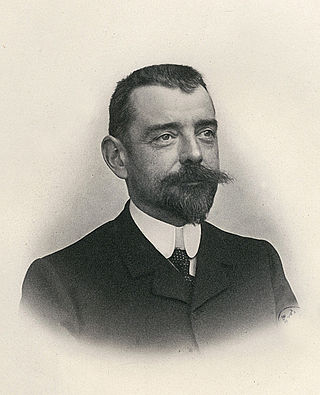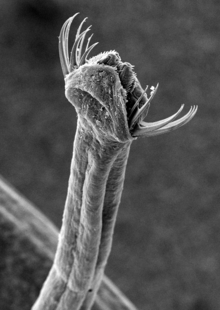
The Chaetognatha or chaetognaths are a phylum of predatory marine worms that are a major component of plankton worldwide. Commonly known as arrow worms, they are mostly nektonic; however about 20% of the known species are benthic, and can attach to algae and rocks. They are found in all marine waters, from surface tropical waters and shallow tide pools to the deep sea and polar regions. Most chaetognaths are transparent and are torpedo shaped, but some deep-sea species are orange. They range in size from 2 to 120 millimetres.

Jean René Constant Quoy was a French naval surgeon, zoologist and anatomist.

A salp or salpa is a barrel-shaped, planktonic tunicate in the family Salpidae. It moves by contracting, thereby pumping water through its gelatinous body; it is one of the most efficient examples of jet propulsion in the animal kingdom. The salp strains the pumped water through its internal feeding filters, feeding on phytoplankton.

Louis Marie Adolphe Olivier Édouard Joubin was a professor at the Muséum national d'Histoire naturelle in Paris. He published works on nemerteans, chaetognatha, cephalopods, and other molluscs.
Eukrohniidae is a family of sagittoideans in the order Phragmophora. It consists of a single genus, Eukrohnia von Ritter-Záhony, 1909.
María de los Ángeles Alvariño González, known as Ángeles Alvariño, was a Spanish fishery research biologist and oceanographer globally recognized as an authority in plankton biology. She was the first woman ever appointed as scientist aboard any British or Spanish exploration ship. She discovered 22 new species of marine animals and published over a hundred scientific books, essays, and articles. In her late career she studied the history of early marine scientific exploration.
Takasi Tokioka was a Japanese zoologist. He published over 200 scientific articles on marine animals such as chaetognaths, ctenophores, and tunicates. He was Professor of Zoology at Kyoto University working at the Seto Marine Biological Laboratory in Shirahama, Japan. From 1975 to 1977, he was the Director of SMBL.
Kikutaro Baba was a Japanese malacologist. He was the leading researcher on sea slugs and bubble snails, opisthobranch gastropod mollusks in Japan.

Sagitta is a genus of Chaetognatha, a phylum commonly known as arrowworms or arrow worms. Phylum Chaetognatha comprises small marine worms.

Parasagitta elegans, the elegant arrow worm, is a small arrow worm in the family Sagittidae, previously named Sagitta elegans

Aphragmophora is an order of sagittodieans in the phylum Chaetognatha.

Phragmophora is an order of sagittoideans in the phylum Chaetognatha.
Krohnittellidae is a family of sagittoideans in the order Phragmophora. It consists of one genus, Krohnittella Germain & Joubin, 1912.
Krohnittidae is a family of chaetognaths in the order Aphragmophora. It consists of a single genus, Krohnitta von Ritter-Záhony, 1910.
Pterokrohniidae is a family of sagittoideans in the order Aphragmophora. I consists of a single genus, Pterokrohnia Srinivasan, 1986, which consists of a single species, Pterokrohnia arabica Srinavasan, 1986.
Pterosagittidae is a family of sagittoideans in the order Aphragmophora. It consists of a single genus, Pterosagitta Costa, 1869, which consists of a single species, Pterosagitta draco.
Spadellidae is a family of sagittoideans in the order Phragmophora. Spadellidae prey on plankton and commonly reside in the epipelagic zone of the ocean.
Caecosagitta macrocephala is a deep sea marine chaetognath that is distributed in meso- and bathypelagic layers. It has a very wide distribution that ranges from the Subantarctic to Subarctic Ocean. Cecosagitta macrocephalas have large heads, hence their name “macro-cephala”. Within their eyes are photoreceptive regions that allow them to catch weak light at bathypelagic depths. Along with their eyes, their gut or intestine has orange pigmentation and a luminous organ that gleams due to bioluminescence unlike some other species of Sagittidae. To be more precise, the luminescent organ is located on the ventral edge of each anterior lateral fin. It is the only member of the genus Caecosagitta, and only one of the two known species of bioluminescent chaetognath, the other being the distantly related Eukrohnia fowleri. C. macrocephala has a secreted bioluminescence that is thought to be coelenterazine based. The luciferase is highly unstable, being unable to survive a single freeze-thaw, and is rapidly inactivated at ice-cold temperatures.
Bathyspadella is a genus of chaetognaths in the family Spadellidae. The genus shares morphological similarities to Eukrohniidae and Spadellidae, although it is molecularly similar to Heterokrohniidae. The unusual position of Bathyspadella would indicate a need to revise the existing order of Phragmophora; however, that would be very difficult, as a number of genera and species exist only in small or difficult to access populations, by which it would be difficult to fully examine all related species. A review of the Chaetognatha, published after the discovery of B. oxydentata, found that the standard division of Phragmophora and Aphragmophora to be improper molecularly, noting the close morphological convergence of the Krohnittidae (Aphragmophora) and Xenokrohnia.
Paraspadella is a genus of chaetognaths in the family Spadellidae. Paraspadella was originally considered as Spadella before a revision separated that genus into three genera: Spadella, Paraspadella, and Gephyrospadella, the last of which is now synonymised to Paraspadella. The initial division was based on previous knowledge of three groups of Spadella, in a similar manner in which Sagitta was divided into a family of genera. Paraspadella is differentiated from Spadella by the presence of disparate (digital) adhesive organs, present in the former to various degrees, but entirely absent in the latter.







